Motivation Theories and Their Impact on Modern Workplace Success
VerifiedAdded on 2023/06/11
|9
|2124
|429
Essay
AI Summary
This essay explores the concept of motivation, its importance in achieving organizational objectives, and its application in the modern workplace. It defines motivation as a process that drives individuals to accomplish goals and highlights the challenges managers face in motivating employees. The essay discusses various motivational theories, including Maslow's Hierarchy of Needs and Hertzberg's Two-Factor Theory, categorizing them into content and process theories. It emphasizes the role of managers in understanding employee needs, creating a positive work environment, and providing opportunities for training and development. The essay also touches upon the Equity Theory and the importance of fair treatment. It concludes that companies should focus on both achieving goals and motivating employees for their personal and professional development, suggesting strategies like training sessions and employee benefit schemes. The application of motivational theories helps managers understand employee needs and create strategies for positive outcomes.
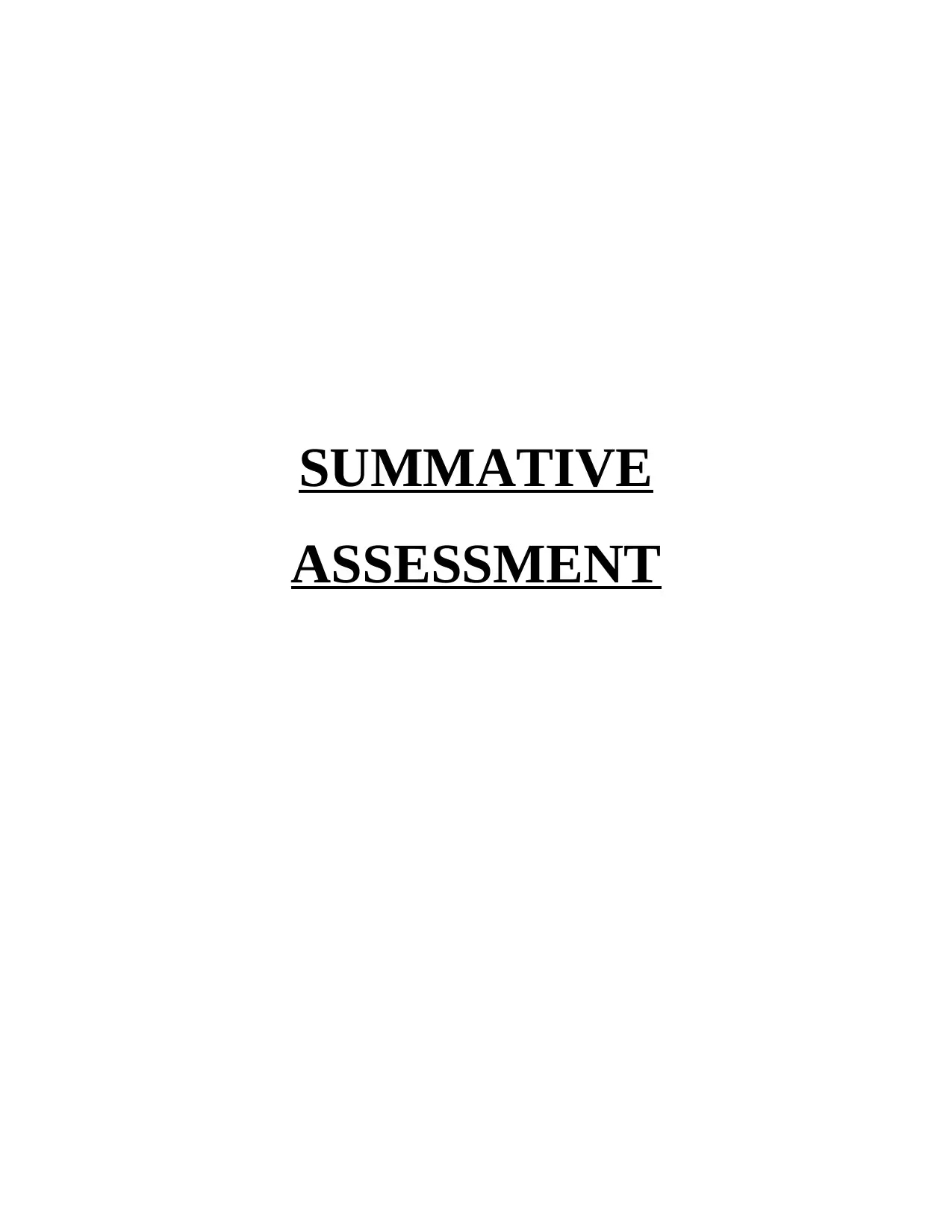
SUMMATIVE
ASSESSMENT
ASSESSMENT
Paraphrase This Document
Need a fresh take? Get an instant paraphrase of this document with our AI Paraphraser
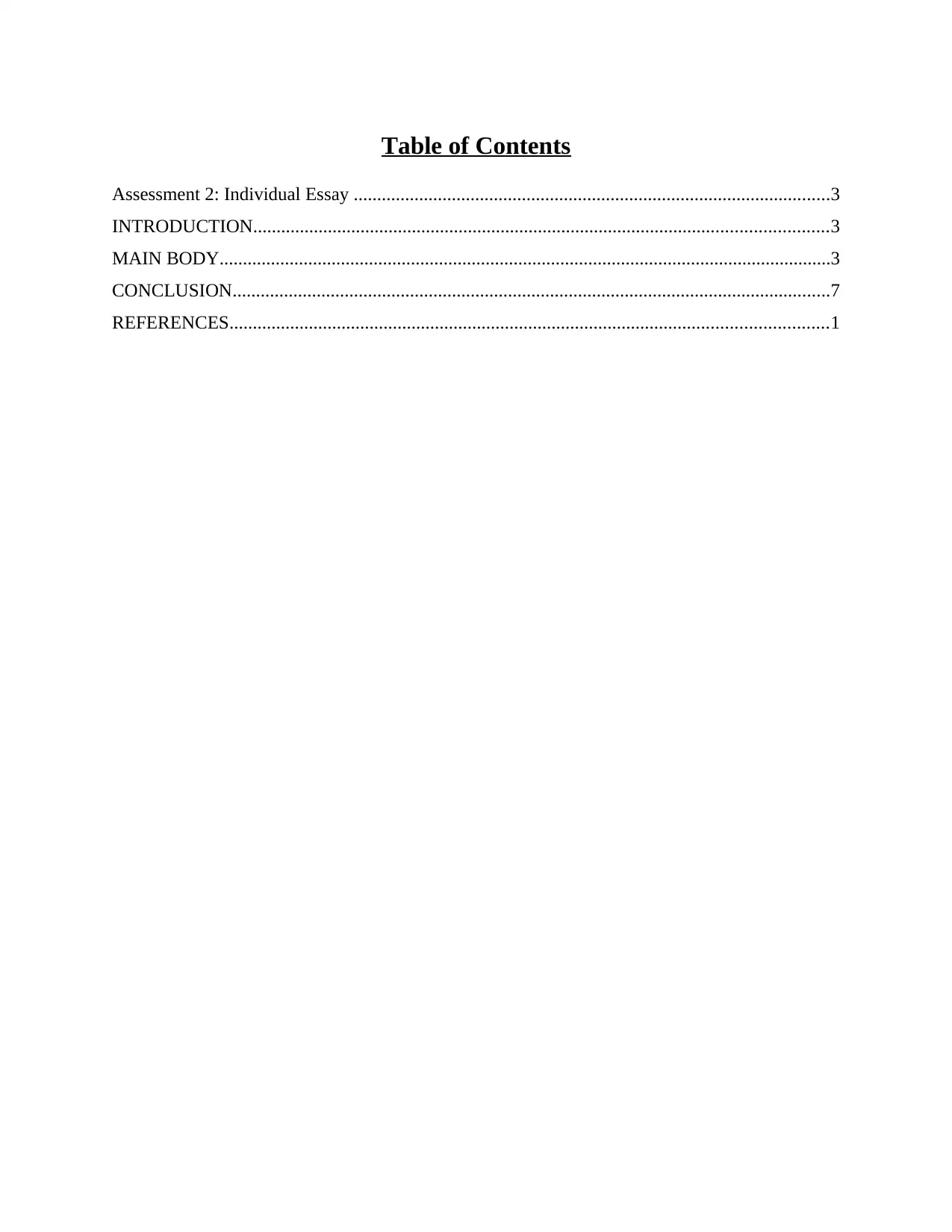
Table of Contents
Assessment 2: Individual Essay ......................................................................................................3
INTRODUCTION...........................................................................................................................3
MAIN BODY...................................................................................................................................3
CONCLUSION................................................................................................................................7
REFERENCES................................................................................................................................1
Assessment 2: Individual Essay ......................................................................................................3
INTRODUCTION...........................................................................................................................3
MAIN BODY...................................................................................................................................3
CONCLUSION................................................................................................................................7
REFERENCES................................................................................................................................1
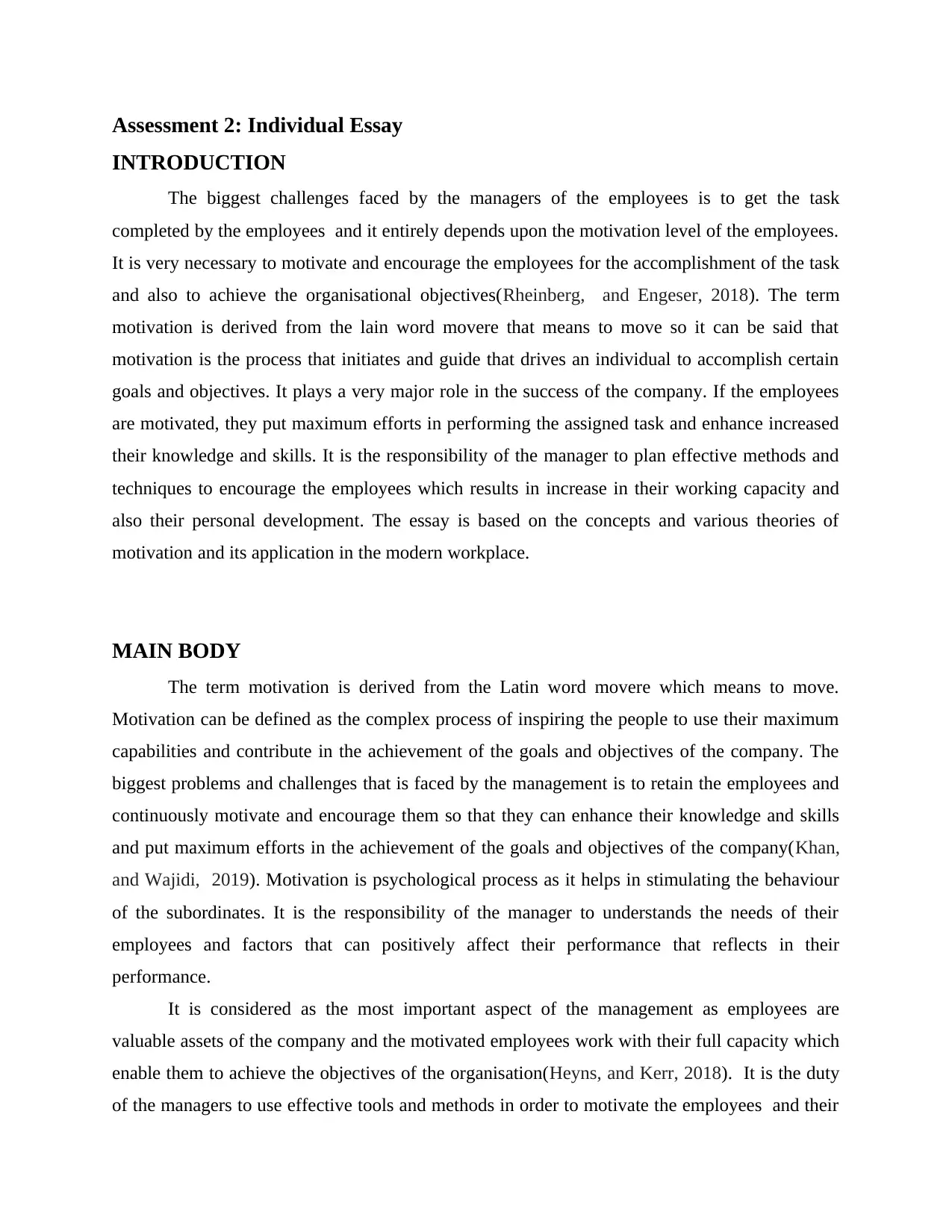
Assessment 2: Individual Essay
INTRODUCTION
The biggest challenges faced by the managers of the employees is to get the task
completed by the employees and it entirely depends upon the motivation level of the employees.
It is very necessary to motivate and encourage the employees for the accomplishment of the task
and also to achieve the organisational objectives(Rheinberg, and Engeser, 2018). The term
motivation is derived from the lain word movere that means to move so it can be said that
motivation is the process that initiates and guide that drives an individual to accomplish certain
goals and objectives. It plays a very major role in the success of the company. If the employees
are motivated, they put maximum efforts in performing the assigned task and enhance increased
their knowledge and skills. It is the responsibility of the manager to plan effective methods and
techniques to encourage the employees which results in increase in their working capacity and
also their personal development. The essay is based on the concepts and various theories of
motivation and its application in the modern workplace.
MAIN BODY
The term motivation is derived from the Latin word movere which means to move.
Motivation can be defined as the complex process of inspiring the people to use their maximum
capabilities and contribute in the achievement of the goals and objectives of the company. The
biggest problems and challenges that is faced by the management is to retain the employees and
continuously motivate and encourage them so that they can enhance their knowledge and skills
and put maximum efforts in the achievement of the goals and objectives of the company(Khan,
and Wajidi, 2019). Motivation is psychological process as it helps in stimulating the behaviour
of the subordinates. It is the responsibility of the manager to understands the needs of their
employees and factors that can positively affect their performance that reflects in their
performance.
It is considered as the most important aspect of the management as employees are
valuable assets of the company and the motivated employees work with their full capacity which
enable them to achieve the objectives of the organisation(Heyns, and Kerr, 2018). It is the duty
of the managers to use effective tools and methods in order to motivate the employees and their
INTRODUCTION
The biggest challenges faced by the managers of the employees is to get the task
completed by the employees and it entirely depends upon the motivation level of the employees.
It is very necessary to motivate and encourage the employees for the accomplishment of the task
and also to achieve the organisational objectives(Rheinberg, and Engeser, 2018). The term
motivation is derived from the lain word movere that means to move so it can be said that
motivation is the process that initiates and guide that drives an individual to accomplish certain
goals and objectives. It plays a very major role in the success of the company. If the employees
are motivated, they put maximum efforts in performing the assigned task and enhance increased
their knowledge and skills. It is the responsibility of the manager to plan effective methods and
techniques to encourage the employees which results in increase in their working capacity and
also their personal development. The essay is based on the concepts and various theories of
motivation and its application in the modern workplace.
MAIN BODY
The term motivation is derived from the Latin word movere which means to move.
Motivation can be defined as the complex process of inspiring the people to use their maximum
capabilities and contribute in the achievement of the goals and objectives of the company. The
biggest problems and challenges that is faced by the management is to retain the employees and
continuously motivate and encourage them so that they can enhance their knowledge and skills
and put maximum efforts in the achievement of the goals and objectives of the company(Khan,
and Wajidi, 2019). Motivation is psychological process as it helps in stimulating the behaviour
of the subordinates. It is the responsibility of the manager to understands the needs of their
employees and factors that can positively affect their performance that reflects in their
performance.
It is considered as the most important aspect of the management as employees are
valuable assets of the company and the motivated employees work with their full capacity which
enable them to achieve the objectives of the organisation(Heyns, and Kerr, 2018). It is the duty
of the managers to use effective tools and methods in order to motivate the employees and their
⊘ This is a preview!⊘
Do you want full access?
Subscribe today to unlock all pages.

Trusted by 1+ million students worldwide
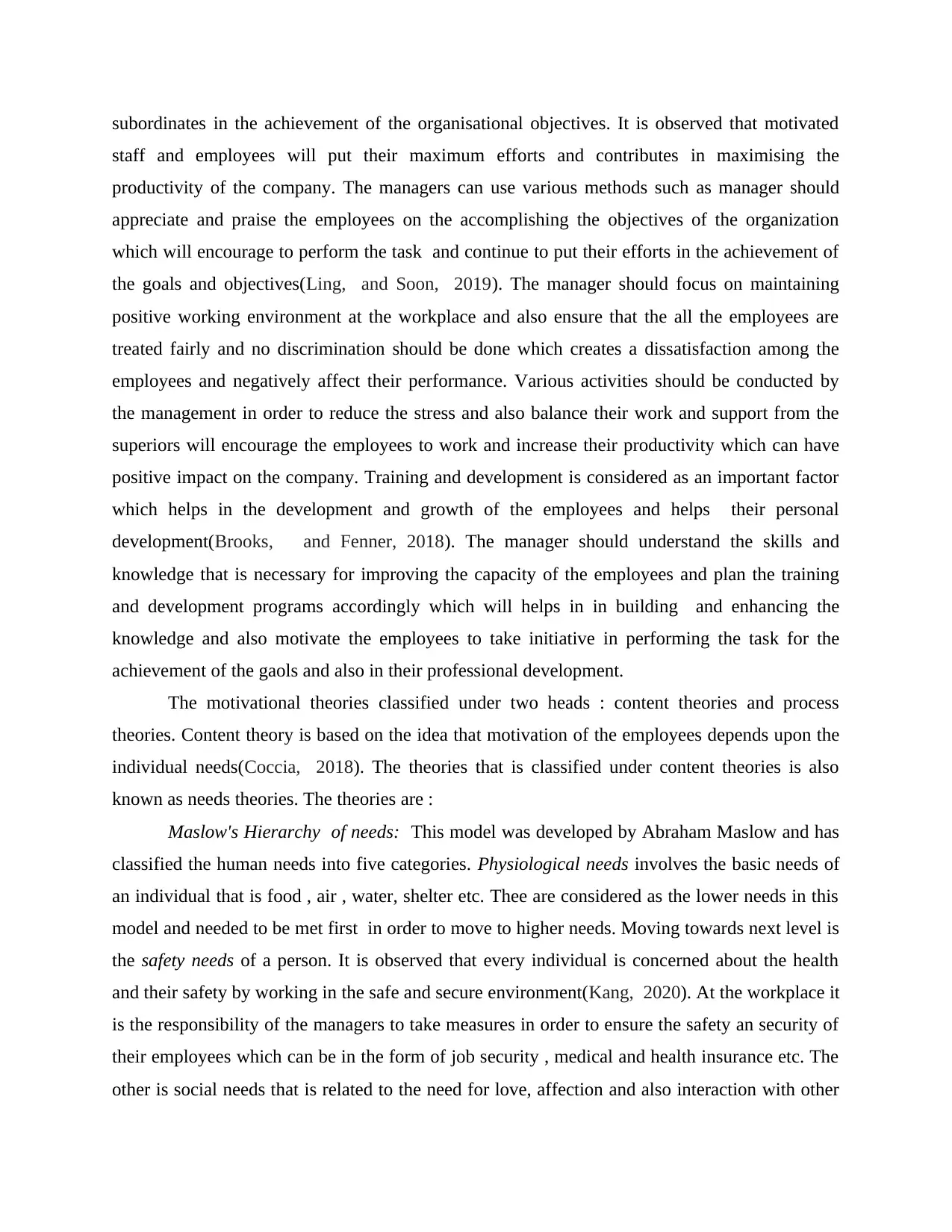
subordinates in the achievement of the organisational objectives. It is observed that motivated
staff and employees will put their maximum efforts and contributes in maximising the
productivity of the company. The managers can use various methods such as manager should
appreciate and praise the employees on the accomplishing the objectives of the organization
which will encourage to perform the task and continue to put their efforts in the achievement of
the goals and objectives(Ling, and Soon, 2019). The manager should focus on maintaining
positive working environment at the workplace and also ensure that the all the employees are
treated fairly and no discrimination should be done which creates a dissatisfaction among the
employees and negatively affect their performance. Various activities should be conducted by
the management in order to reduce the stress and also balance their work and support from the
superiors will encourage the employees to work and increase their productivity which can have
positive impact on the company. Training and development is considered as an important factor
which helps in the development and growth of the employees and helps their personal
development(Brooks, and Fenner, 2018). The manager should understand the skills and
knowledge that is necessary for improving the capacity of the employees and plan the training
and development programs accordingly which will helps in in building and enhancing the
knowledge and also motivate the employees to take initiative in performing the task for the
achievement of the gaols and also in their professional development.
The motivational theories classified under two heads : content theories and process
theories. Content theory is based on the idea that motivation of the employees depends upon the
individual needs(Coccia, 2018). The theories that is classified under content theories is also
known as needs theories. The theories are :
Maslow's Hierarchy of needs: This model was developed by Abraham Maslow and has
classified the human needs into five categories. Physiological needs involves the basic needs of
an individual that is food , air , water, shelter etc. Thee are considered as the lower needs in this
model and needed to be met first in order to move to higher needs. Moving towards next level is
the safety needs of a person. It is observed that every individual is concerned about the health
and their safety by working in the safe and secure environment(Kang, 2020). At the workplace it
is the responsibility of the managers to take measures in order to ensure the safety an security of
their employees which can be in the form of job security , medical and health insurance etc. The
other is social needs that is related to the need for love, affection and also interaction with other
staff and employees will put their maximum efforts and contributes in maximising the
productivity of the company. The managers can use various methods such as manager should
appreciate and praise the employees on the accomplishing the objectives of the organization
which will encourage to perform the task and continue to put their efforts in the achievement of
the goals and objectives(Ling, and Soon, 2019). The manager should focus on maintaining
positive working environment at the workplace and also ensure that the all the employees are
treated fairly and no discrimination should be done which creates a dissatisfaction among the
employees and negatively affect their performance. Various activities should be conducted by
the management in order to reduce the stress and also balance their work and support from the
superiors will encourage the employees to work and increase their productivity which can have
positive impact on the company. Training and development is considered as an important factor
which helps in the development and growth of the employees and helps their personal
development(Brooks, and Fenner, 2018). The manager should understand the skills and
knowledge that is necessary for improving the capacity of the employees and plan the training
and development programs accordingly which will helps in in building and enhancing the
knowledge and also motivate the employees to take initiative in performing the task for the
achievement of the gaols and also in their professional development.
The motivational theories classified under two heads : content theories and process
theories. Content theory is based on the idea that motivation of the employees depends upon the
individual needs(Coccia, 2018). The theories that is classified under content theories is also
known as needs theories. The theories are :
Maslow's Hierarchy of needs: This model was developed by Abraham Maslow and has
classified the human needs into five categories. Physiological needs involves the basic needs of
an individual that is food , air , water, shelter etc. Thee are considered as the lower needs in this
model and needed to be met first in order to move to higher needs. Moving towards next level is
the safety needs of a person. It is observed that every individual is concerned about the health
and their safety by working in the safe and secure environment(Kang, 2020). At the workplace it
is the responsibility of the managers to take measures in order to ensure the safety an security of
their employees which can be in the form of job security , medical and health insurance etc. The
other is social needs that is related to the need for love, affection and also interaction with other
Paraphrase This Document
Need a fresh take? Get an instant paraphrase of this document with our AI Paraphraser
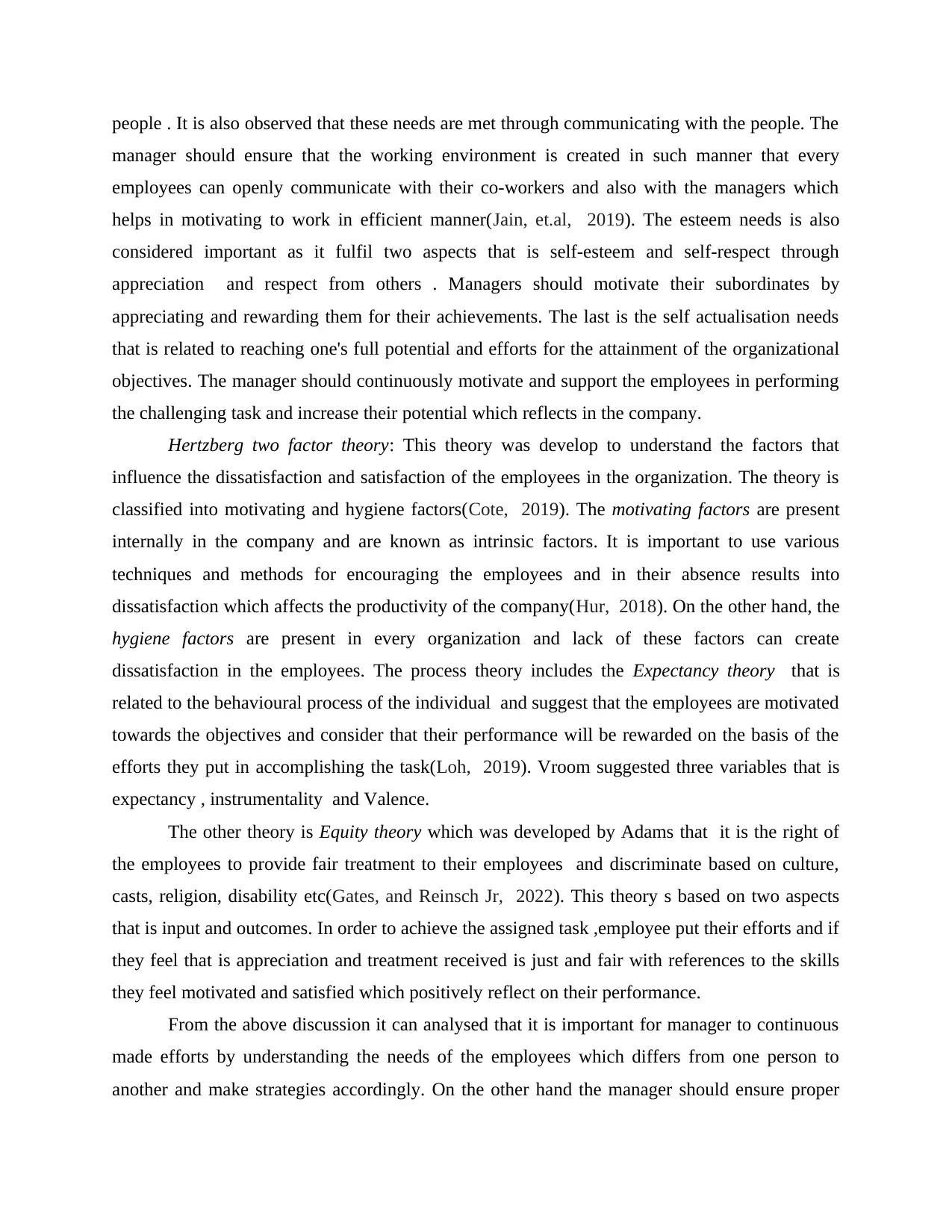
people . It is also observed that these needs are met through communicating with the people. The
manager should ensure that the working environment is created in such manner that every
employees can openly communicate with their co-workers and also with the managers which
helps in motivating to work in efficient manner(Jain, et.al, 2019). The esteem needs is also
considered important as it fulfil two aspects that is self-esteem and self-respect through
appreciation and respect from others . Managers should motivate their subordinates by
appreciating and rewarding them for their achievements. The last is the self actualisation needs
that is related to reaching one's full potential and efforts for the attainment of the organizational
objectives. The manager should continuously motivate and support the employees in performing
the challenging task and increase their potential which reflects in the company.
Hertzberg two factor theory: This theory was develop to understand the factors that
influence the dissatisfaction and satisfaction of the employees in the organization. The theory is
classified into motivating and hygiene factors(Cote, 2019). The motivating factors are present
internally in the company and are known as intrinsic factors. It is important to use various
techniques and methods for encouraging the employees and in their absence results into
dissatisfaction which affects the productivity of the company(Hur, 2018). On the other hand, the
hygiene factors are present in every organization and lack of these factors can create
dissatisfaction in the employees. The process theory includes the Expectancy theory that is
related to the behavioural process of the individual and suggest that the employees are motivated
towards the objectives and consider that their performance will be rewarded on the basis of the
efforts they put in accomplishing the task(Loh, 2019). Vroom suggested three variables that is
expectancy , instrumentality and Valence.
The other theory is Equity theory which was developed by Adams that it is the right of
the employees to provide fair treatment to their employees and discriminate based on culture,
casts, religion, disability etc(Gates, and Reinsch Jr, 2022). This theory s based on two aspects
that is input and outcomes. In order to achieve the assigned task ,employee put their efforts and if
they feel that is appreciation and treatment received is just and fair with references to the skills
they feel motivated and satisfied which positively reflect on their performance.
From the above discussion it can analysed that it is important for manager to continuous
made efforts by understanding the needs of the employees which differs from one person to
another and make strategies accordingly. On the other hand the manager should ensure proper
manager should ensure that the working environment is created in such manner that every
employees can openly communicate with their co-workers and also with the managers which
helps in motivating to work in efficient manner(Jain, et.al, 2019). The esteem needs is also
considered important as it fulfil two aspects that is self-esteem and self-respect through
appreciation and respect from others . Managers should motivate their subordinates by
appreciating and rewarding them for their achievements. The last is the self actualisation needs
that is related to reaching one's full potential and efforts for the attainment of the organizational
objectives. The manager should continuously motivate and support the employees in performing
the challenging task and increase their potential which reflects in the company.
Hertzberg two factor theory: This theory was develop to understand the factors that
influence the dissatisfaction and satisfaction of the employees in the organization. The theory is
classified into motivating and hygiene factors(Cote, 2019). The motivating factors are present
internally in the company and are known as intrinsic factors. It is important to use various
techniques and methods for encouraging the employees and in their absence results into
dissatisfaction which affects the productivity of the company(Hur, 2018). On the other hand, the
hygiene factors are present in every organization and lack of these factors can create
dissatisfaction in the employees. The process theory includes the Expectancy theory that is
related to the behavioural process of the individual and suggest that the employees are motivated
towards the objectives and consider that their performance will be rewarded on the basis of the
efforts they put in accomplishing the task(Loh, 2019). Vroom suggested three variables that is
expectancy , instrumentality and Valence.
The other theory is Equity theory which was developed by Adams that it is the right of
the employees to provide fair treatment to their employees and discriminate based on culture,
casts, religion, disability etc(Gates, and Reinsch Jr, 2022). This theory s based on two aspects
that is input and outcomes. In order to achieve the assigned task ,employee put their efforts and if
they feel that is appreciation and treatment received is just and fair with references to the skills
they feel motivated and satisfied which positively reflect on their performance.
From the above discussion it can analysed that it is important for manager to continuous
made efforts by understanding the needs of the employees which differs from one person to
another and make strategies accordingly. On the other hand the manager should ensure proper
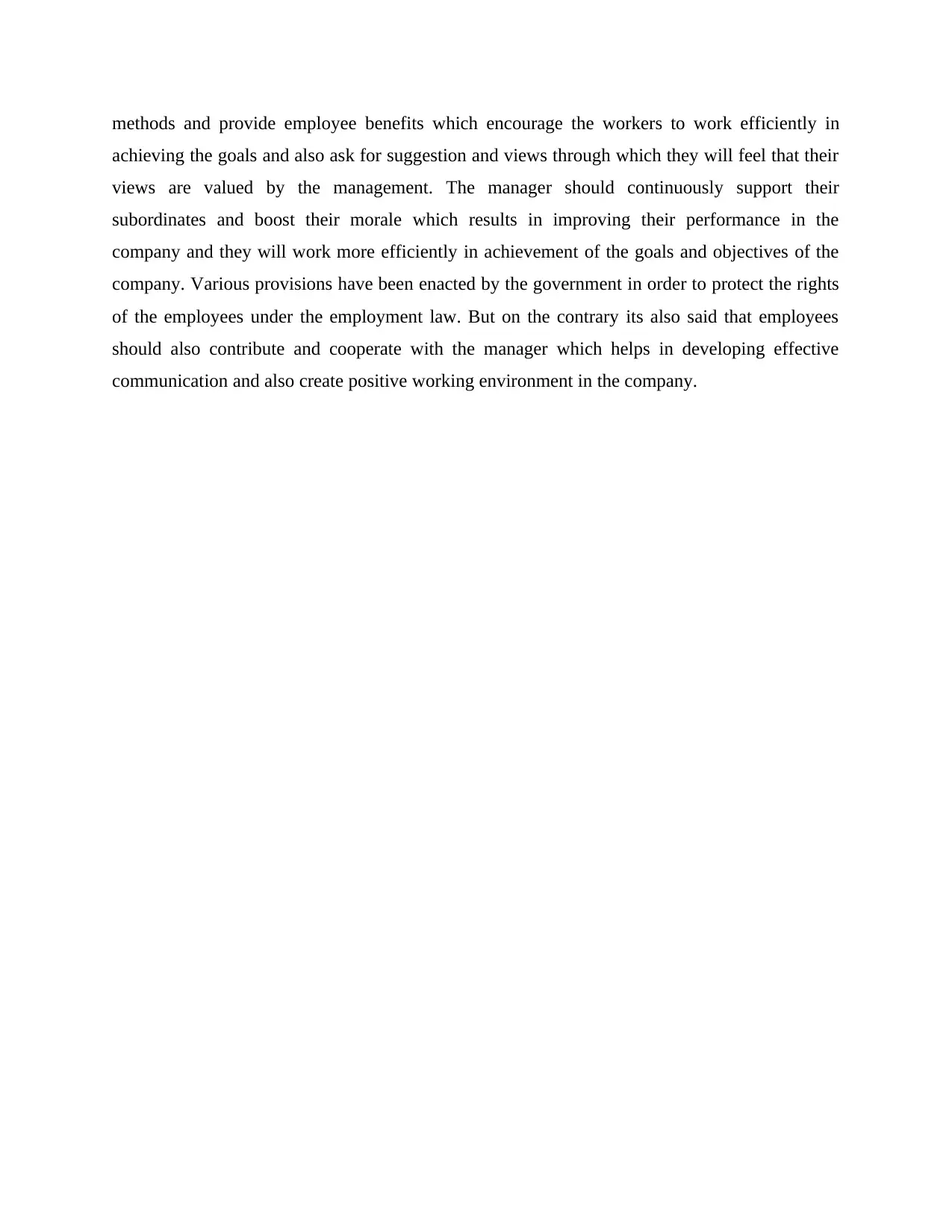
methods and provide employee benefits which encourage the workers to work efficiently in
achieving the goals and also ask for suggestion and views through which they will feel that their
views are valued by the management. The manager should continuously support their
subordinates and boost their morale which results in improving their performance in the
company and they will work more efficiently in achievement of the goals and objectives of the
company. Various provisions have been enacted by the government in order to protect the rights
of the employees under the employment law. But on the contrary its also said that employees
should also contribute and cooperate with the manager which helps in developing effective
communication and also create positive working environment in the company.
achieving the goals and also ask for suggestion and views through which they will feel that their
views are valued by the management. The manager should continuously support their
subordinates and boost their morale which results in improving their performance in the
company and they will work more efficiently in achievement of the goals and objectives of the
company. Various provisions have been enacted by the government in order to protect the rights
of the employees under the employment law. But on the contrary its also said that employees
should also contribute and cooperate with the manager which helps in developing effective
communication and also create positive working environment in the company.
⊘ This is a preview!⊘
Do you want full access?
Subscribe today to unlock all pages.

Trusted by 1+ million students worldwide
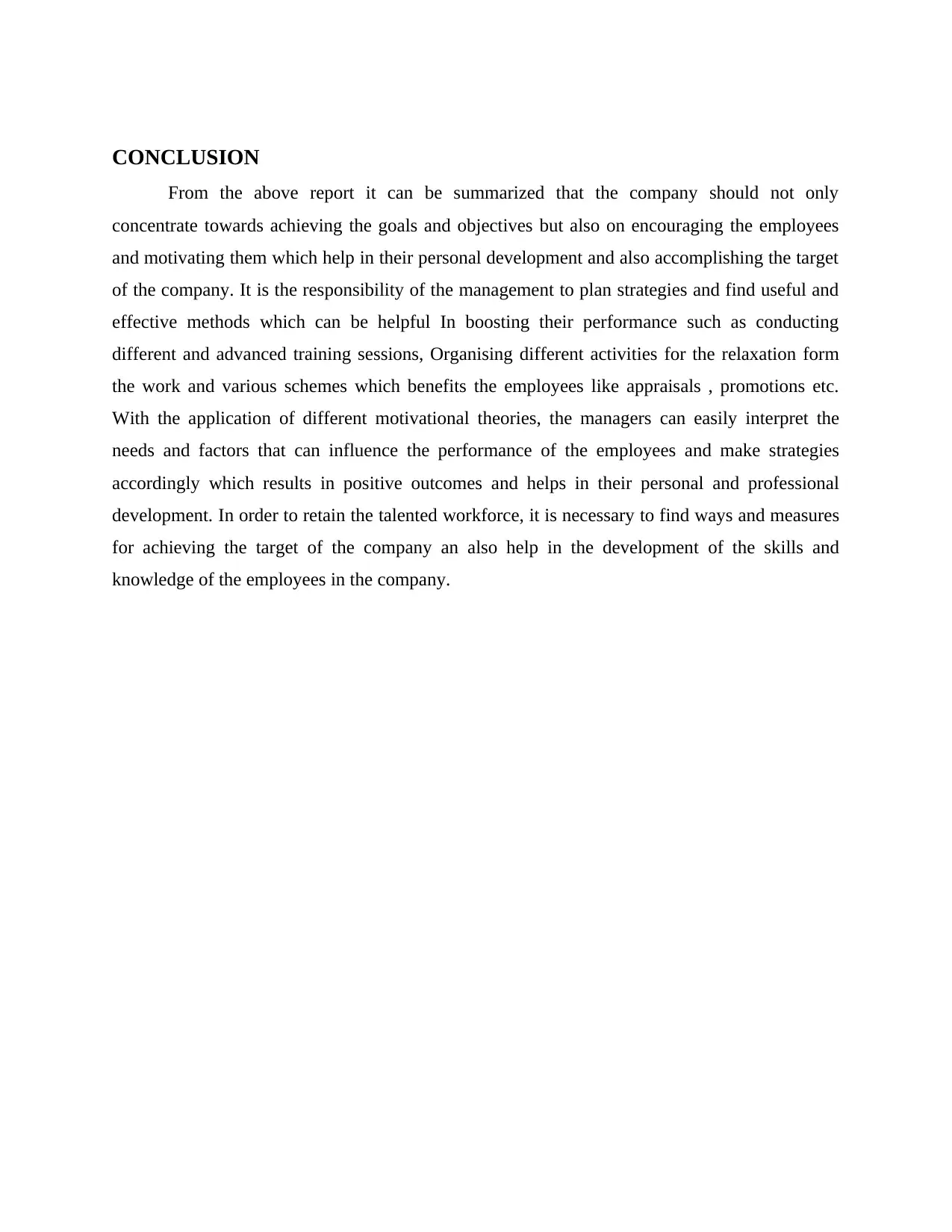
CONCLUSION
From the above report it can be summarized that the company should not only
concentrate towards achieving the goals and objectives but also on encouraging the employees
and motivating them which help in their personal development and also accomplishing the target
of the company. It is the responsibility of the management to plan strategies and find useful and
effective methods which can be helpful In boosting their performance such as conducting
different and advanced training sessions, Organising different activities for the relaxation form
the work and various schemes which benefits the employees like appraisals , promotions etc.
With the application of different motivational theories, the managers can easily interpret the
needs and factors that can influence the performance of the employees and make strategies
accordingly which results in positive outcomes and helps in their personal and professional
development. In order to retain the talented workforce, it is necessary to find ways and measures
for achieving the target of the company an also help in the development of the skills and
knowledge of the employees in the company.
From the above report it can be summarized that the company should not only
concentrate towards achieving the goals and objectives but also on encouraging the employees
and motivating them which help in their personal development and also accomplishing the target
of the company. It is the responsibility of the management to plan strategies and find useful and
effective methods which can be helpful In boosting their performance such as conducting
different and advanced training sessions, Organising different activities for the relaxation form
the work and various schemes which benefits the employees like appraisals , promotions etc.
With the application of different motivational theories, the managers can easily interpret the
needs and factors that can influence the performance of the employees and make strategies
accordingly which results in positive outcomes and helps in their personal and professional
development. In order to retain the talented workforce, it is necessary to find ways and measures
for achieving the target of the company an also help in the development of the skills and
knowledge of the employees in the company.
Paraphrase This Document
Need a fresh take? Get an instant paraphrase of this document with our AI Paraphraser
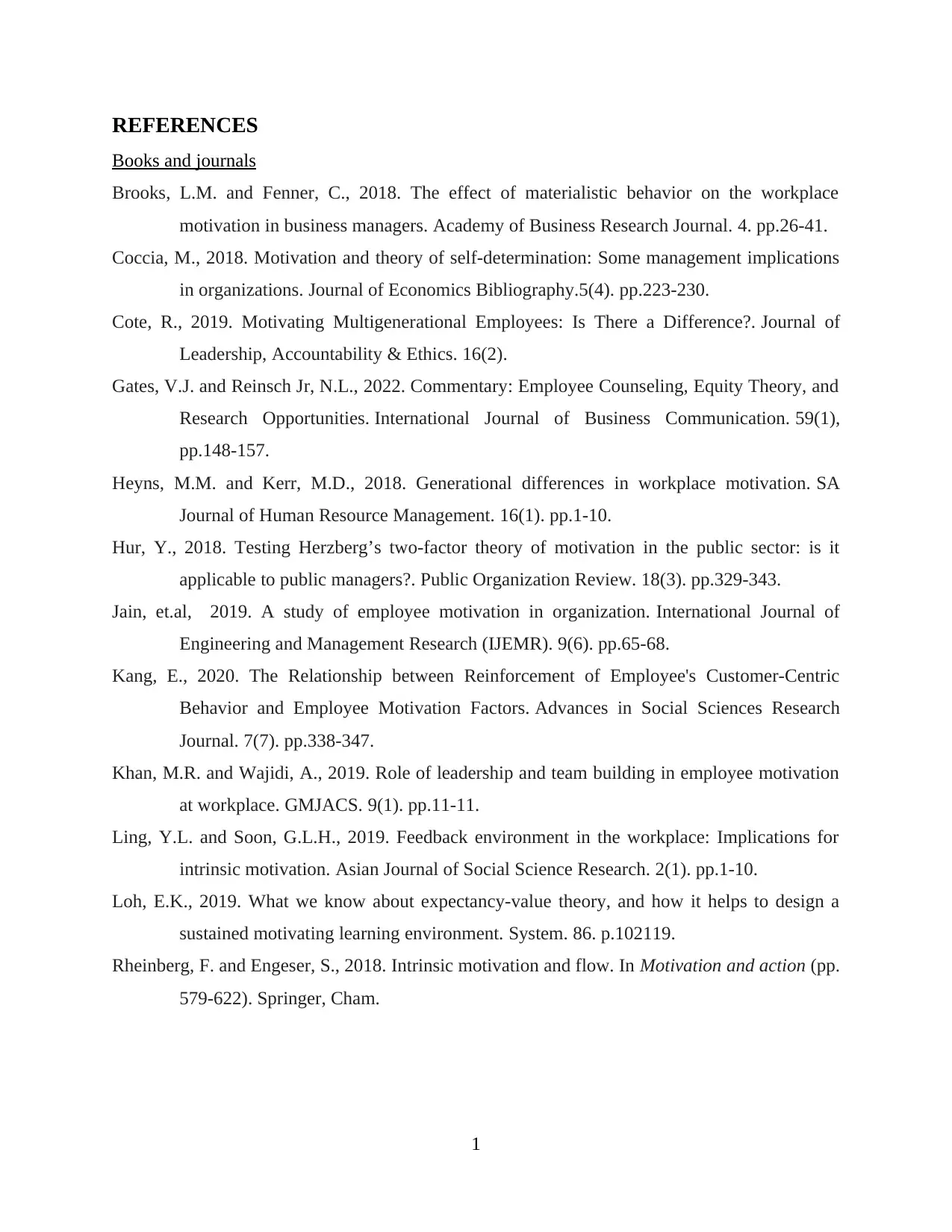
REFERENCES
Books and journals
Brooks, L.M. and Fenner, C., 2018. The effect of materialistic behavior on the workplace
motivation in business managers. Academy of Business Research Journal. 4. pp.26-41.
Coccia, M., 2018. Motivation and theory of self-determination: Some management implications
in organizations. Journal of Economics Bibliography.5(4). pp.223-230.
Cote, R., 2019. Motivating Multigenerational Employees: Is There a Difference?. Journal of
Leadership, Accountability & Ethics. 16(2).
Gates, V.J. and Reinsch Jr, N.L., 2022. Commentary: Employee Counseling, Equity Theory, and
Research Opportunities. International Journal of Business Communication. 59(1),
pp.148-157.
Heyns, M.M. and Kerr, M.D., 2018. Generational differences in workplace motivation. SA
Journal of Human Resource Management. 16(1). pp.1-10.
Hur, Y., 2018. Testing Herzberg’s two-factor theory of motivation in the public sector: is it
applicable to public managers?. Public Organization Review. 18(3). pp.329-343.
Jain, et.al, 2019. A study of employee motivation in organization. International Journal of
Engineering and Management Research (IJEMR). 9(6). pp.65-68.
Kang, E., 2020. The Relationship between Reinforcement of Employee's Customer-Centric
Behavior and Employee Motivation Factors. Advances in Social Sciences Research
Journal. 7(7). pp.338-347.
Khan, M.R. and Wajidi, A., 2019. Role of leadership and team building in employee motivation
at workplace. GMJACS. 9(1). pp.11-11.
Ling, Y.L. and Soon, G.L.H., 2019. Feedback environment in the workplace: Implications for
intrinsic motivation. Asian Journal of Social Science Research. 2(1). pp.1-10.
Loh, E.K., 2019. What we know about expectancy-value theory, and how it helps to design a
sustained motivating learning environment. System. 86. p.102119.
Rheinberg, F. and Engeser, S., 2018. Intrinsic motivation and flow. In Motivation and action (pp.
579-622). Springer, Cham.
1
Books and journals
Brooks, L.M. and Fenner, C., 2018. The effect of materialistic behavior on the workplace
motivation in business managers. Academy of Business Research Journal. 4. pp.26-41.
Coccia, M., 2018. Motivation and theory of self-determination: Some management implications
in organizations. Journal of Economics Bibliography.5(4). pp.223-230.
Cote, R., 2019. Motivating Multigenerational Employees: Is There a Difference?. Journal of
Leadership, Accountability & Ethics. 16(2).
Gates, V.J. and Reinsch Jr, N.L., 2022. Commentary: Employee Counseling, Equity Theory, and
Research Opportunities. International Journal of Business Communication. 59(1),
pp.148-157.
Heyns, M.M. and Kerr, M.D., 2018. Generational differences in workplace motivation. SA
Journal of Human Resource Management. 16(1). pp.1-10.
Hur, Y., 2018. Testing Herzberg’s two-factor theory of motivation in the public sector: is it
applicable to public managers?. Public Organization Review. 18(3). pp.329-343.
Jain, et.al, 2019. A study of employee motivation in organization. International Journal of
Engineering and Management Research (IJEMR). 9(6). pp.65-68.
Kang, E., 2020. The Relationship between Reinforcement of Employee's Customer-Centric
Behavior and Employee Motivation Factors. Advances in Social Sciences Research
Journal. 7(7). pp.338-347.
Khan, M.R. and Wajidi, A., 2019. Role of leadership and team building in employee motivation
at workplace. GMJACS. 9(1). pp.11-11.
Ling, Y.L. and Soon, G.L.H., 2019. Feedback environment in the workplace: Implications for
intrinsic motivation. Asian Journal of Social Science Research. 2(1). pp.1-10.
Loh, E.K., 2019. What we know about expectancy-value theory, and how it helps to design a
sustained motivating learning environment. System. 86. p.102119.
Rheinberg, F. and Engeser, S., 2018. Intrinsic motivation and flow. In Motivation and action (pp.
579-622). Springer, Cham.
1
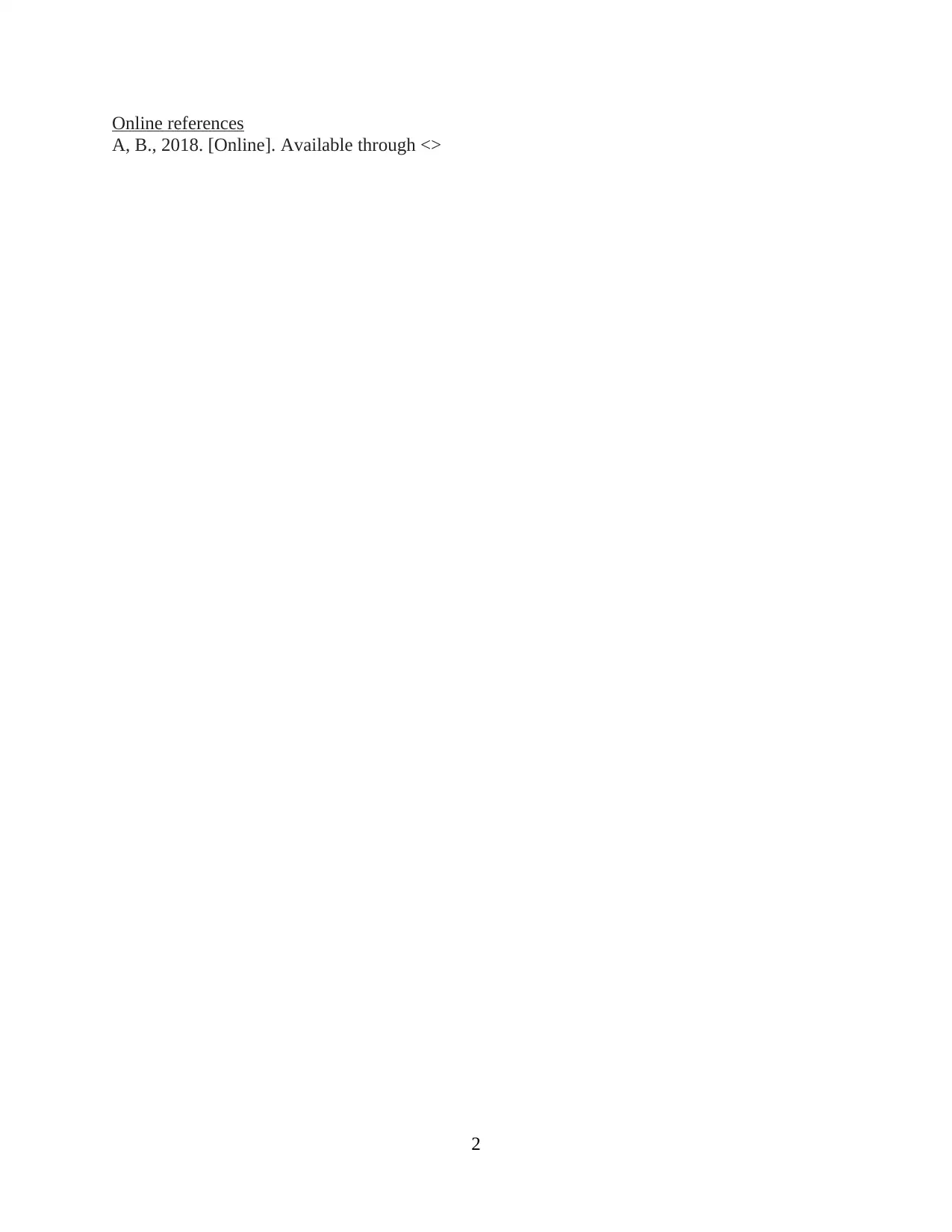
Online references
A, B., 2018. [Online]. Available through <>
2
A, B., 2018. [Online]. Available through <>
2
⊘ This is a preview!⊘
Do you want full access?
Subscribe today to unlock all pages.

Trusted by 1+ million students worldwide
1 out of 9
Related Documents
Your All-in-One AI-Powered Toolkit for Academic Success.
+13062052269
info@desklib.com
Available 24*7 on WhatsApp / Email
![[object Object]](/_next/static/media/star-bottom.7253800d.svg)
Unlock your academic potential
Copyright © 2020–2025 A2Z Services. All Rights Reserved. Developed and managed by ZUCOL.


